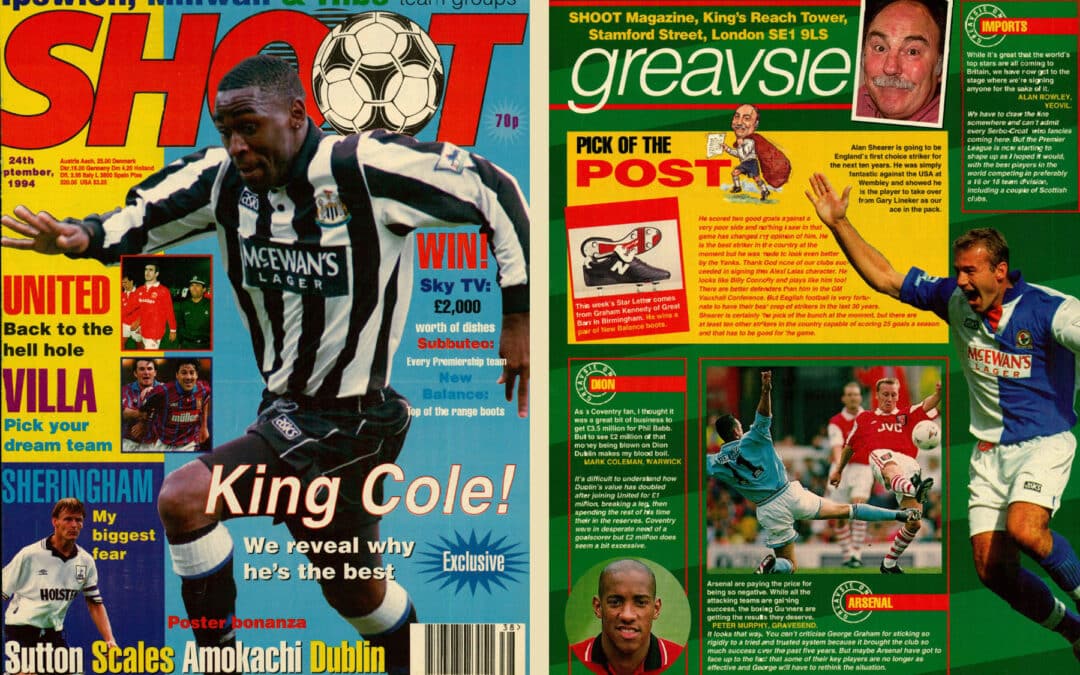Step into a time machine with us and let’s set the dial for this very day in 1994. The Premier League was still in its infancy, football kits were gloriously baggy, and for many young fans, the highlight of the week was a trip to the newsagent to pick up the latest issue of SHOOT Magazine.
This particular edition from 1994 is a perfect snapshot of the era. Gracing the cover is a confident, young Andy Cole, then the hottest property in English football, boldly making his case as “the best.” Inside, readers were treated to the wit and wisdom of Jimmy Greaves, a gallery of star players, and a pull-out poster that would have adorned thousands of bedroom walls. Join us as we leaf through this classic issue and revisit a golden age of football, reminding ourselves why magazines like SHOOT were an essential part of the beautiful game.
The Reign of King Cole
The cover star, Andy Cole, was the man of the moment. In the 1993-94 season, his first full top-flight campaign, he had been nothing short of a phenomenon for Newcastle United. Scoring an incredible 34 league goals in 40 appearances, he fired Kevin Keegan’s newly-promoted side to a third-place finish and a spot in the UEFA Cup. Cole’s blend of explosive pace, intelligent movement, and ruthless finishing made him the most feared striker in the country.
The SHOOT headline, “Why I’m The Best,” wasn’t just clickbait before the term existed; it was a reflection of his undeniable form. Cole’s confidence was sky-high, and he had the goals to back it up. He had just won the PFA Young Player of the Year award, and his partnership with Peter Beardsley was the stuff of dreams for the Toon Army.
This cover story would have seen Cole breaking down his game, discussing his ambitions, and giving young, aspiring strikers tips on how to find the back of the net. At a time when players were less media-trained, interviews in magazines like SHOOT offered a rare, authentic glimpse into their personalities. Cole’s declaration of being “the best” was a bold statement, putting him in direct comparison with established stars like Alan Shearer, Ian Wright, and Eric Cantona. It was the kind of confident talk that fuelled playground debates across the country for the entire week.
Greavsie’s Say
Flip a few pages past the Andy Cole feature, and you’d inevitably land on Jimmy Greaves’ column. By 1994, Greavsie was long retired from his record-breaking playing career but had carved out a second life as one of football’s most beloved pundits. Alongside Ian St. John on the “Saint and Greavsie” show, he was a Saturday lunchtime institution.
His column in SHOOT was an extension of that on-screen persona: witty, insightful, and always straight-talking. Greavsie had a unique ability to cut through the noise and get to the heart of a matter, whether he was discussing a manager under pressure, a controversial refereeing decision, or the form of a particular team.
In an era before 24-hour sports news and endless social media chatter, Greaves’ column was a trusted source of opinion. He wasn’t afraid to be critical, but it was always balanced with a deep love and understanding of the game. For the young reader, his column was an education in football analysis, delivered with a familiar, avuncular charm. He provided the kind of talking points you’d take with you to school on Monday morning, ready to impress your mates with your newfound knowledge.
The Legendary Millwall Wall Poster
One of SHOOT’s most beloved features was the pull-out poster. Every issue featured a giant, glossy photo of a team or a star player, ready to be carefully removed and stuck on a bedroom wall with a bit of Blu Tack. These posters were badges of honour, a public declaration of your allegiance.
This particular issue from 1994 contained a team photo of Millwall, gearing up for the 1994-95 season. For Lions fans, this poster was a must-have. Managed by Mick McCarthy, Millwall had just come agonisingly close to promotion to the Premier League, finishing third in the old First Division before losing in the play-off semi-finals.
The team featured some proper club legends. In goal was the USA international Kasey Keller. The squad also included tough-tackling defenders like Kenny Cunningham and future Premier League players such as the young, tenacious midfielder Tim Cahill’s predecessors, like Alex Rae. Up front, they had the goalscoring prowess of players who embodied the spirit of The Den. This poster wasn’t just a picture; it was a statement of hope and pride for the season ahead. It represented the gritty, passionate, and often misunderstood identity of a club like Millwall, a world away from the glamour of the newly formed Premier League.
More Than a Magazine
Looking back at this single issue of SHOOT provides a powerful dose of nostalgia. It reminds us of a time when football felt more accessible and less corporate. The articles were written with a genuine passion for the sport, aimed at a young audience hungry for information about their heroes.
SHOOT, along with its rivals like Match and Match of the Day Magazine, was a vital part of football culture. It was how you learned the stats, read about the rising stars, and got your weekly fix of posters, quizzes, and competitions. It was a tangible connection to the game you loved, something to be read and re-read, with favourite pages bookmarked until the next issue came out.
This cover from 1994 captures a specific moment in time perfectly—Andy Cole at the peak of his powers, the reliable wisdom of Jimmy Greaves, and the tribal pride of a club like Millwall. It’s a snapshot of 90s football in all its glory.
What Happened Next?
Andy Cole’s bold claim on the cover proved to be a prelude to one of the most shocking transfers of the era. Just a few months later, in January 1995, he made a sensational £7 million move to Manchester United, a British record fee. He would go on to win five Premier League titles, two FA Cups, and the Champions League, cementing his place as one of the league’s all-time great strikers.
Millwall, meanwhile, would again challenge for promotion in the 94-95 season, but their form tailed off, and they finished mid-table. The dream of Premier League football at The Den would have to wait.
This issue of SHOOT is more than just an old magazine; it’s a time capsule. It represents an era when football was on the cusp of enormous change, but still retained the raw, uncomplicated joy that made us all fall in love with it in the first place. Do you remember this cover? Perhaps you had the Millwall poster on your wall, or maybe you were busy arguing that Shearer was better than Cole. Share your memories with us.

